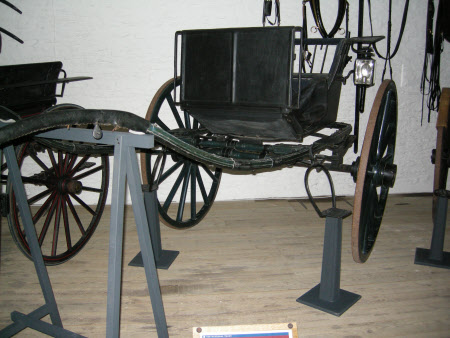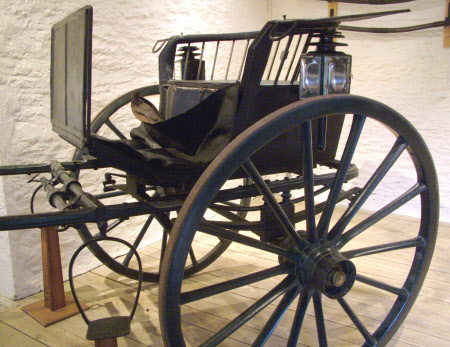Stanhope gig
Turrill and Sons
Category
Carriages & other vehicles
Date
1830
Materials
Painted wood body with wool upholstery and two iron shod wheels.
Measurements
166.5 x 348 x 188.5cm (5ft 5 1/2in x 11ft 5in x 6ft 2 1/4in)
Place of origin
London
Order this imageCollection
National Trust Carriage Museum
NT 272878.1
Caption
One of the most popular gigs, it was produced in vast numbers. This made it very affordable and popular with country sportsmen and commercial travellers owing to its lightness and the valuable luggage space in the boot. Designed by the Hon. Fitzroy Stanhope it was made by the coachbuilder Tilbury. The design was much lighter than the heavier Tilbury Gig due to the compact “telegraph” springs.
Summary
Stanhope Gig built by Turrill and Sons of London circa 1830. Stanhope Gig (two wheels) for a single horse. This carriage has a storm apron, leaf springs and shafts. In dark green livery with dark blue interior trim and two candle lamps.
Full description
The Hon. Fitzroy Stanhope used a coachbuilder called Tilbury and, between them, they designed two very different styles of gigs which bore their names, early in the 19th century. The Tilbury gig was very comfortable, but was also rather heavy and expensive and did not last long in favour, whereas the Stanhope gig was an immediate success, was built in large numbers, and provided the basis for the designs of many later gigs. It has two distinctive features. The body is mounted on “telegraph” springs, consisting of two side springs and two cross springs, the same as the front or back set on a four-in-hand coach, and the shafts are continuous and wrap around the back of the body. Its large boot made it very practical and, in addition to being used by country sportsmen, sometimes driven tandem, it was often used by commercial travellers in making their calls. They would hire one in each town visited, make their rounds, and then move on by train. This example, although undated, is undoubtedly old, and is possibly the only early example to have survived, which makes it a very important carriage.
Provenance
owned by the Marquis of Bute
Marks and inscriptions
On lamps.: TURRILL, LONDON On front nearside axle cap.: TURRILL & SONS, LONDON On front offside axle cap.: TURRILL & SONS, LONDON On rear nearside axle cap.: TURRILL & SONS, LONDON On rear offside axle cap.: TURRILL & SONS, LONDON On front nearside axle components.: MASONS PATENT LONDON On front offside axle components.: MASONS PATENT LONDON On rear nearside axle components.: MASONS PATENT LONDON On rear offside axle components.: MASONS PATENT LONDON
Makers and roles
Turrill and Sons, coach builder


